Business Strategy and Sustainability
VerifiedAdded on 2020/01/21
|14
|4155
|1203
AI Summary
This assignment delves into the crucial interplay between business strategy and sustainable practices. It requires students to analyze various frameworks such as Porter's Value Chain and resource-based theory to understand how companies can balance profit maximization with environmental and social responsibility. The assignment also encourages critical evaluation of case studies, demonstrating the implementation of sustainable strategies in real-world business scenarios.
Contribute Materials
Your contribution can guide someone’s learning journey. Share your
documents today.
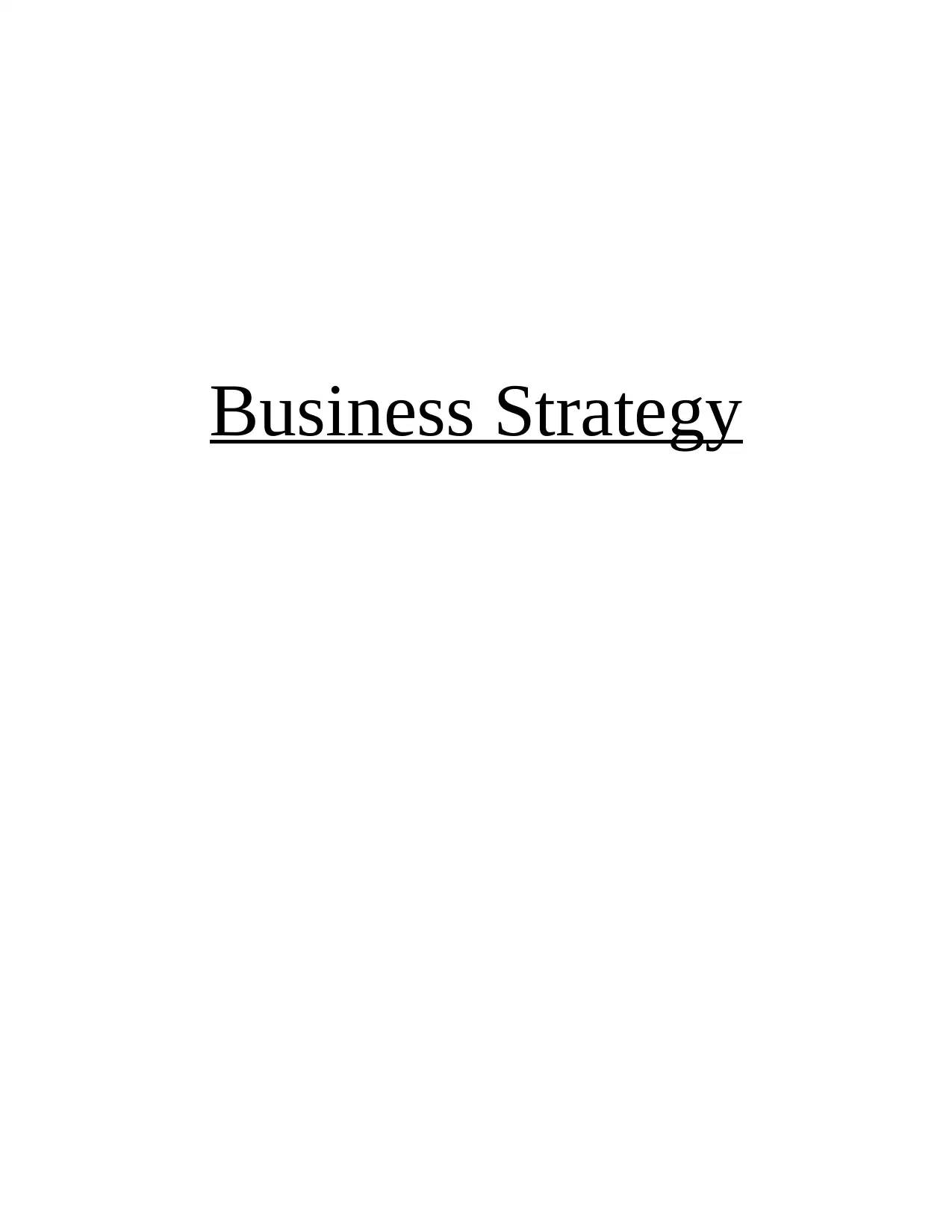
Business Strategy
Secure Best Marks with AI Grader
Need help grading? Try our AI Grader for instant feedback on your assignments.
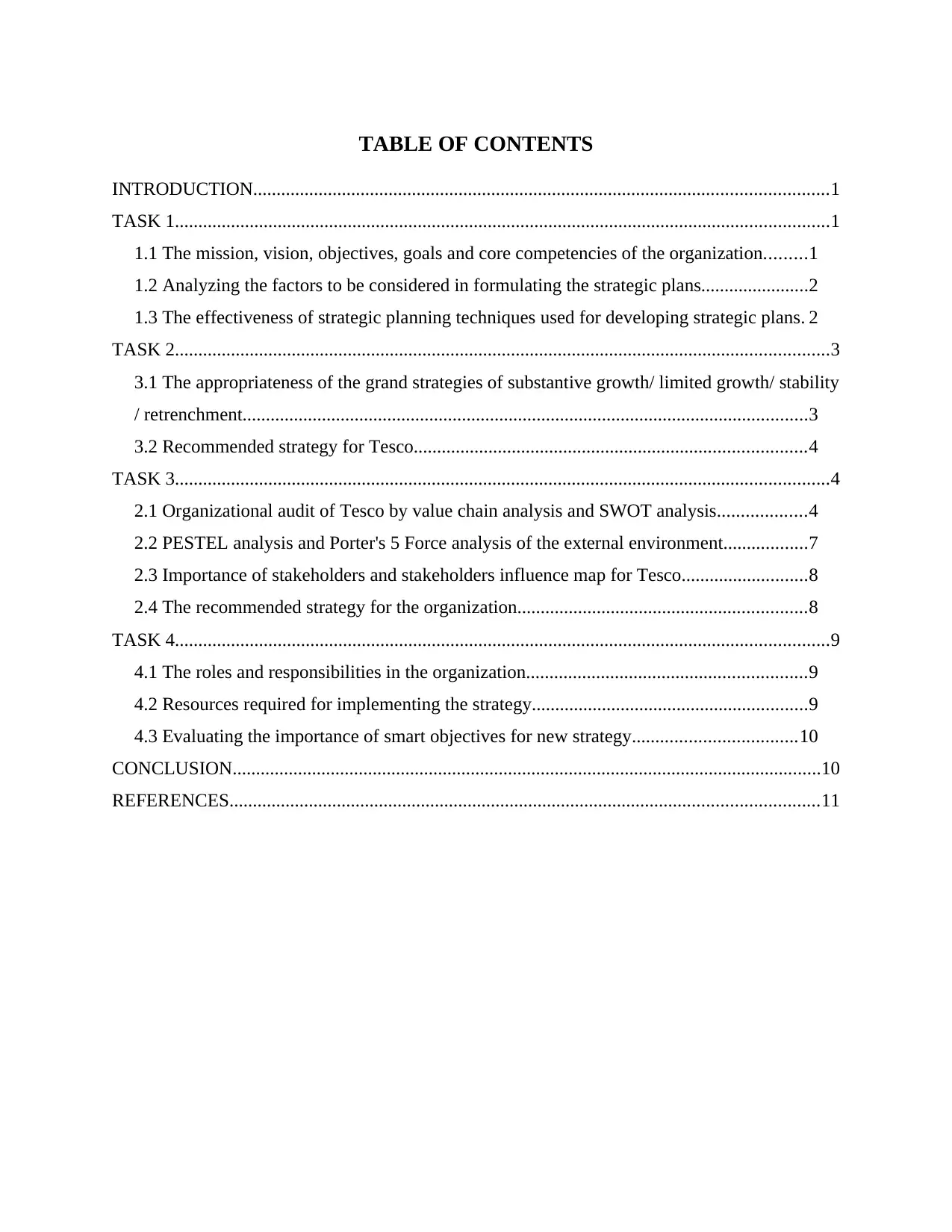
TABLE OF CONTENTS
INTRODUCTION...........................................................................................................................1
TASK 1............................................................................................................................................1
1.1 The mission, vision, objectives, goals and core competencies of the organization.........1
1.2 Analyzing the factors to be considered in formulating the strategic plans.......................2
1.3 The effectiveness of strategic planning techniques used for developing strategic plans. 2
TASK 2............................................................................................................................................3
3.1 The appropriateness of the grand strategies of substantive growth/ limited growth/ stability
/ retrenchment.........................................................................................................................3
3.2 Recommended strategy for Tesco....................................................................................4
TASK 3............................................................................................................................................4
2.1 Organizational audit of Tesco by value chain analysis and SWOT analysis...................4
2.2 PESTEL analysis and Porter's 5 Force analysis of the external environment..................7
2.3 Importance of stakeholders and stakeholders influence map for Tesco...........................8
2.4 The recommended strategy for the organization..............................................................8
TASK 4............................................................................................................................................9
4.1 The roles and responsibilities in the organization............................................................9
4.2 Resources required for implementing the strategy...........................................................9
4.3 Evaluating the importance of smart objectives for new strategy...................................10
CONCLUSION..............................................................................................................................10
REFERENCES..............................................................................................................................11
INTRODUCTION...........................................................................................................................1
TASK 1............................................................................................................................................1
1.1 The mission, vision, objectives, goals and core competencies of the organization.........1
1.2 Analyzing the factors to be considered in formulating the strategic plans.......................2
1.3 The effectiveness of strategic planning techniques used for developing strategic plans. 2
TASK 2............................................................................................................................................3
3.1 The appropriateness of the grand strategies of substantive growth/ limited growth/ stability
/ retrenchment.........................................................................................................................3
3.2 Recommended strategy for Tesco....................................................................................4
TASK 3............................................................................................................................................4
2.1 Organizational audit of Tesco by value chain analysis and SWOT analysis...................4
2.2 PESTEL analysis and Porter's 5 Force analysis of the external environment..................7
2.3 Importance of stakeholders and stakeholders influence map for Tesco...........................8
2.4 The recommended strategy for the organization..............................................................8
TASK 4............................................................................................................................................9
4.1 The roles and responsibilities in the organization............................................................9
4.2 Resources required for implementing the strategy...........................................................9
4.3 Evaluating the importance of smart objectives for new strategy...................................10
CONCLUSION..............................................................................................................................10
REFERENCES..............................................................................................................................11
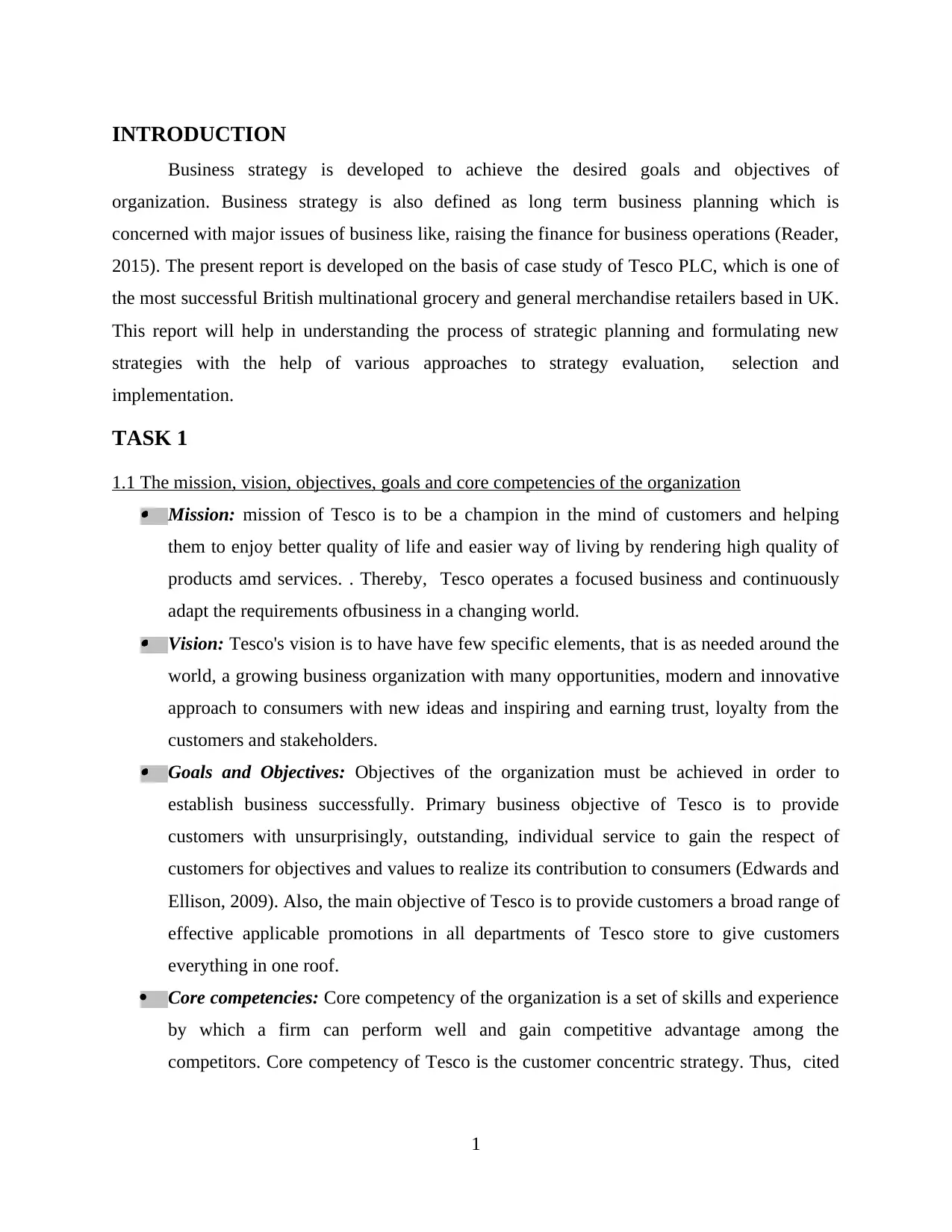
INTRODUCTION
Business strategy is developed to achieve the desired goals and objectives of
organization. Business strategy is also defined as long term business planning which is
concerned with major issues of business like, raising the finance for business operations (Reader,
2015). The present report is developed on the basis of case study of Tesco PLC, which is one of
the most successful British multinational grocery and general merchandise retailers based in UK.
This report will help in understanding the process of strategic planning and formulating new
strategies with the help of various approaches to strategy evaluation, selection and
implementation.
TASK 1
1.1 The mission, vision, objectives, goals and core competencies of the organization Mission: mission of Tesco is to be a champion in the mind of customers and helping
them to enjoy better quality of life and easier way of living by rendering high quality of
products amd services. . Thereby, Tesco operates a focused business and continuously
adapt the requirements ofbusiness in a changing world. Vision: Tesco's vision is to have have few specific elements, that is as needed around the
world, a growing business organization with many opportunities, modern and innovative
approach to consumers with new ideas and inspiring and earning trust, loyalty from the
customers and stakeholders. Goals and Objectives: Objectives of the organization must be achieved in order to
establish business successfully. Primary business objective of Tesco is to provide
customers with unsurprisingly, outstanding, individual service to gain the respect of
customers for objectives and values to realize its contribution to consumers (Edwards and
Ellison, 2009). Also, the main objective of Tesco is to provide customers a broad range of
effective applicable promotions in all departments of Tesco store to give customers
everything in one roof.
Core competencies: Core competency of the organization is a set of skills and experience
by which a firm can perform well and gain competitive advantage among the
competitors. Core competency of Tesco is the customer concentric strategy. Thus, cited
1
Business strategy is developed to achieve the desired goals and objectives of
organization. Business strategy is also defined as long term business planning which is
concerned with major issues of business like, raising the finance for business operations (Reader,
2015). The present report is developed on the basis of case study of Tesco PLC, which is one of
the most successful British multinational grocery and general merchandise retailers based in UK.
This report will help in understanding the process of strategic planning and formulating new
strategies with the help of various approaches to strategy evaluation, selection and
implementation.
TASK 1
1.1 The mission, vision, objectives, goals and core competencies of the organization Mission: mission of Tesco is to be a champion in the mind of customers and helping
them to enjoy better quality of life and easier way of living by rendering high quality of
products amd services. . Thereby, Tesco operates a focused business and continuously
adapt the requirements ofbusiness in a changing world. Vision: Tesco's vision is to have have few specific elements, that is as needed around the
world, a growing business organization with many opportunities, modern and innovative
approach to consumers with new ideas and inspiring and earning trust, loyalty from the
customers and stakeholders. Goals and Objectives: Objectives of the organization must be achieved in order to
establish business successfully. Primary business objective of Tesco is to provide
customers with unsurprisingly, outstanding, individual service to gain the respect of
customers for objectives and values to realize its contribution to consumers (Edwards and
Ellison, 2009). Also, the main objective of Tesco is to provide customers a broad range of
effective applicable promotions in all departments of Tesco store to give customers
everything in one roof.
Core competencies: Core competency of the organization is a set of skills and experience
by which a firm can perform well and gain competitive advantage among the
competitors. Core competency of Tesco is the customer concentric strategy. Thus, cited
1

firm implements various techniques to collect, analyze and understand the customers
well.
1.2 Analyzing the factors to be considered in formulating the strategic plans
The essential factors that have to be considered at the time of formulating the strategic
plans is as follows, Availability of resources: Main factor that has to be considered for formulating strategic
plan is the availability of resources Since, Tesco is operating successful grocery and
general merchandise retail business in many national and international cities. So, Tesco
requires to ensure the availability of fresh and quality products as per the consumer
demands. Short term and long term objectives: The one more specific factor that must have to be
considered for formulating strategic plan is that strategic plan is must have developed by
considering short term and long term goals and objectives of the organization (Baye and
Beil, 2006). Achievement of short term and long term targets of the organization helps in
achieving the success of strategic business plan of the organization.
Research and development: To formulate strategic planning, it is necessary to ensure the
proper research of all the business factors and competitors which will put impact on
strategic planning. Any new service or product launch after research leads to the possible
opportunities and success of the strategic plan. Thus, Tesco must consider all these
important factors for formulating strategic plan.
1.3 The effectiveness of strategic planning techniques used for developing strategic plans
The Strategic planning techniques used in Tesco is BCG matrix and PIMS. The
effectiveness of these techniques for developing the strategic plans is as follows, BCG Matrix: BCG matrix helps Tesco effectively in developing strategic plan. BCG
matrix involves market growth and market share for the strategic planning of business,
products and services. It helps in identifying the current portfolio of the cited firm and
develops strategic plan accordingly (Ritter and Gemünden, 2004). Through basic
measurement as well as with market share and growth rate, Management of Tesco
identifies the current market scenario of resources and competitive strength of the cited
firm in the market. With regards to BCG matrix, Tesco generates the fund that is required
2
well.
1.2 Analyzing the factors to be considered in formulating the strategic plans
The essential factors that have to be considered at the time of formulating the strategic
plans is as follows, Availability of resources: Main factor that has to be considered for formulating strategic
plan is the availability of resources Since, Tesco is operating successful grocery and
general merchandise retail business in many national and international cities. So, Tesco
requires to ensure the availability of fresh and quality products as per the consumer
demands. Short term and long term objectives: The one more specific factor that must have to be
considered for formulating strategic plan is that strategic plan is must have developed by
considering short term and long term goals and objectives of the organization (Baye and
Beil, 2006). Achievement of short term and long term targets of the organization helps in
achieving the success of strategic business plan of the organization.
Research and development: To formulate strategic planning, it is necessary to ensure the
proper research of all the business factors and competitors which will put impact on
strategic planning. Any new service or product launch after research leads to the possible
opportunities and success of the strategic plan. Thus, Tesco must consider all these
important factors for formulating strategic plan.
1.3 The effectiveness of strategic planning techniques used for developing strategic plans
The Strategic planning techniques used in Tesco is BCG matrix and PIMS. The
effectiveness of these techniques for developing the strategic plans is as follows, BCG Matrix: BCG matrix helps Tesco effectively in developing strategic plan. BCG
matrix involves market growth and market share for the strategic planning of business,
products and services. It helps in identifying the current portfolio of the cited firm and
develops strategic plan accordingly (Ritter and Gemünden, 2004). Through basic
measurement as well as with market share and growth rate, Management of Tesco
identifies the current market scenario of resources and competitive strength of the cited
firm in the market. With regards to BCG matrix, Tesco generates the fund that is required
2
Secure Best Marks with AI Grader
Need help grading? Try our AI Grader for instant feedback on your assignments.
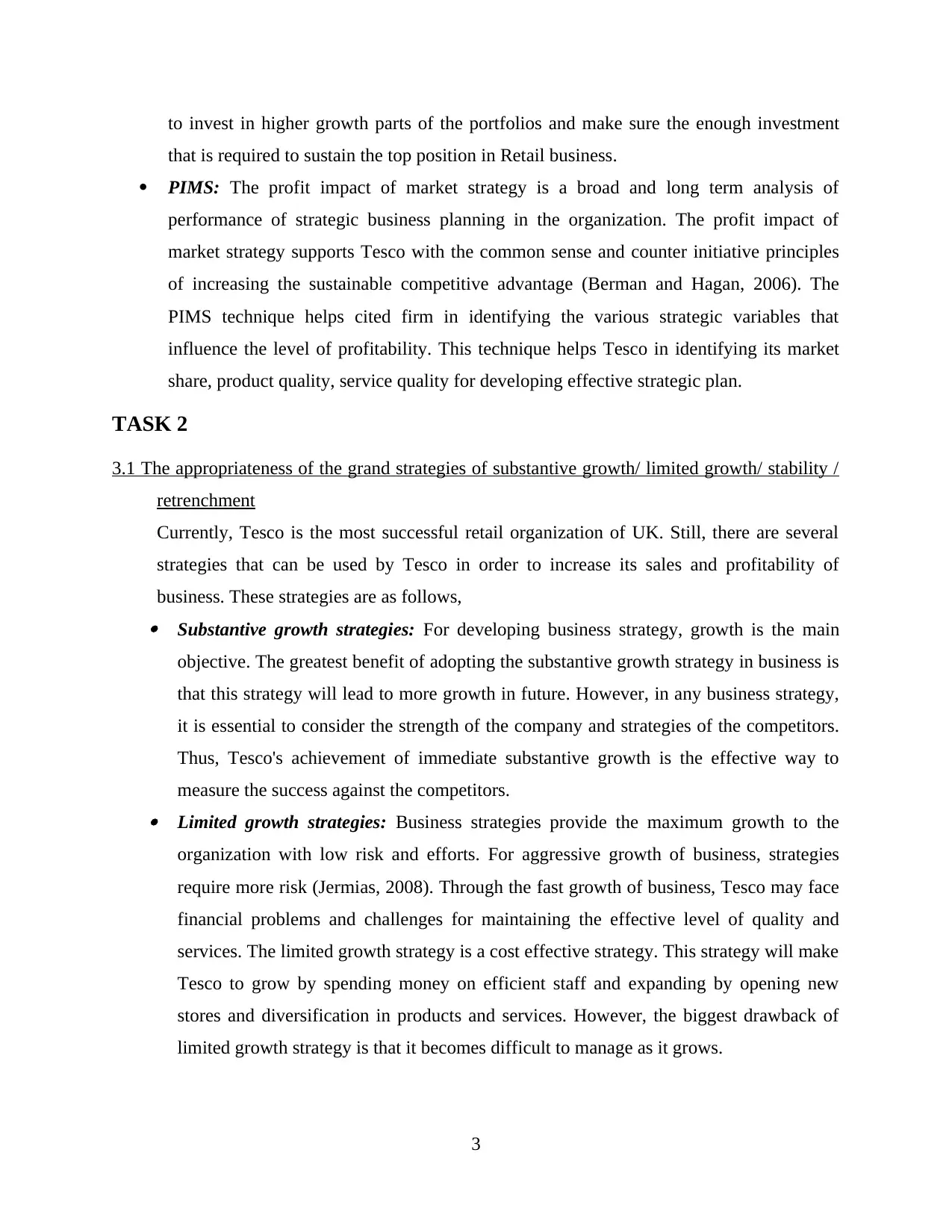
to invest in higher growth parts of the portfolios and make sure the enough investment
that is required to sustain the top position in Retail business.
PIMS: The profit impact of market strategy is a broad and long term analysis of
performance of strategic business planning in the organization. The profit impact of
market strategy supports Tesco with the common sense and counter initiative principles
of increasing the sustainable competitive advantage (Berman and Hagan, 2006). The
PIMS technique helps cited firm in identifying the various strategic variables that
influence the level of profitability. This technique helps Tesco in identifying its market
share, product quality, service quality for developing effective strategic plan.
TASK 2
3.1 The appropriateness of the grand strategies of substantive growth/ limited growth/ stability /
retrenchment
Currently, Tesco is the most successful retail organization of UK. Still, there are several
strategies that can be used by Tesco in order to increase its sales and profitability of
business. These strategies are as follows, Substantive growth strategies: For developing business strategy, growth is the main
objective. The greatest benefit of adopting the substantive growth strategy in business is
that this strategy will lead to more growth in future. However, in any business strategy,
it is essential to consider the strength of the company and strategies of the competitors.
Thus, Tesco's achievement of immediate substantive growth is the effective way to
measure the success against the competitors. Limited growth strategies: Business strategies provide the maximum growth to the
organization with low risk and efforts. For aggressive growth of business, strategies
require more risk (Jermias, 2008). Through the fast growth of business, Tesco may face
financial problems and challenges for maintaining the effective level of quality and
services. The limited growth strategy is a cost effective strategy. This strategy will make
Tesco to grow by spending money on efficient staff and expanding by opening new
stores and diversification in products and services. However, the biggest drawback of
limited growth strategy is that it becomes difficult to manage as it grows.
3
that is required to sustain the top position in Retail business.
PIMS: The profit impact of market strategy is a broad and long term analysis of
performance of strategic business planning in the organization. The profit impact of
market strategy supports Tesco with the common sense and counter initiative principles
of increasing the sustainable competitive advantage (Berman and Hagan, 2006). The
PIMS technique helps cited firm in identifying the various strategic variables that
influence the level of profitability. This technique helps Tesco in identifying its market
share, product quality, service quality for developing effective strategic plan.
TASK 2
3.1 The appropriateness of the grand strategies of substantive growth/ limited growth/ stability /
retrenchment
Currently, Tesco is the most successful retail organization of UK. Still, there are several
strategies that can be used by Tesco in order to increase its sales and profitability of
business. These strategies are as follows, Substantive growth strategies: For developing business strategy, growth is the main
objective. The greatest benefit of adopting the substantive growth strategy in business is
that this strategy will lead to more growth in future. However, in any business strategy,
it is essential to consider the strength of the company and strategies of the competitors.
Thus, Tesco's achievement of immediate substantive growth is the effective way to
measure the success against the competitors. Limited growth strategies: Business strategies provide the maximum growth to the
organization with low risk and efforts. For aggressive growth of business, strategies
require more risk (Jermias, 2008). Through the fast growth of business, Tesco may face
financial problems and challenges for maintaining the effective level of quality and
services. The limited growth strategy is a cost effective strategy. This strategy will make
Tesco to grow by spending money on efficient staff and expanding by opening new
stores and diversification in products and services. However, the biggest drawback of
limited growth strategy is that it becomes difficult to manage as it grows.
3
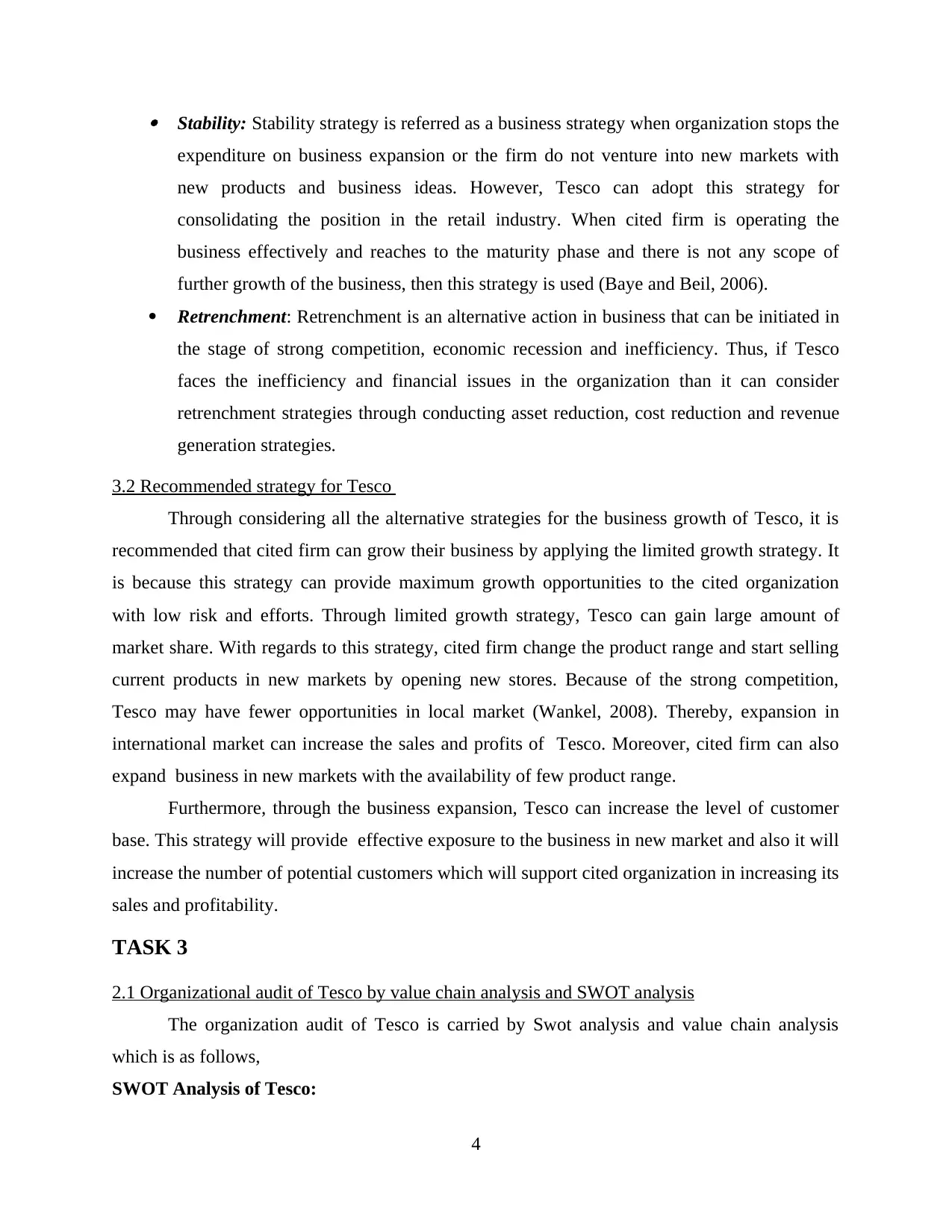
Stability: Stability strategy is referred as a business strategy when organization stops the
expenditure on business expansion or the firm do not venture into new markets with
new products and business ideas. However, Tesco can adopt this strategy for
consolidating the position in the retail industry. When cited firm is operating the
business effectively and reaches to the maturity phase and there is not any scope of
further growth of the business, then this strategy is used (Baye and Beil, 2006).
Retrenchment: Retrenchment is an alternative action in business that can be initiated in
the stage of strong competition, economic recession and inefficiency. Thus, if Tesco
faces the inefficiency and financial issues in the organization than it can consider
retrenchment strategies through conducting asset reduction, cost reduction and revenue
generation strategies.
3.2 Recommended strategy for Tesco
Through considering all the alternative strategies for the business growth of Tesco, it is
recommended that cited firm can grow their business by applying the limited growth strategy. It
is because this strategy can provide maximum growth opportunities to the cited organization
with low risk and efforts. Through limited growth strategy, Tesco can gain large amount of
market share. With regards to this strategy, cited firm change the product range and start selling
current products in new markets by opening new stores. Because of the strong competition,
Tesco may have fewer opportunities in local market (Wankel, 2008). Thereby, expansion in
international market can increase the sales and profits of Tesco. Moreover, cited firm can also
expand business in new markets with the availability of few product range.
Furthermore, through the business expansion, Tesco can increase the level of customer
base. This strategy will provide effective exposure to the business in new market and also it will
increase the number of potential customers which will support cited organization in increasing its
sales and profitability.
TASK 3
2.1 Organizational audit of Tesco by value chain analysis and SWOT analysis
The organization audit of Tesco is carried by Swot analysis and value chain analysis
which is as follows,
SWOT Analysis of Tesco:
4
expenditure on business expansion or the firm do not venture into new markets with
new products and business ideas. However, Tesco can adopt this strategy for
consolidating the position in the retail industry. When cited firm is operating the
business effectively and reaches to the maturity phase and there is not any scope of
further growth of the business, then this strategy is used (Baye and Beil, 2006).
Retrenchment: Retrenchment is an alternative action in business that can be initiated in
the stage of strong competition, economic recession and inefficiency. Thus, if Tesco
faces the inefficiency and financial issues in the organization than it can consider
retrenchment strategies through conducting asset reduction, cost reduction and revenue
generation strategies.
3.2 Recommended strategy for Tesco
Through considering all the alternative strategies for the business growth of Tesco, it is
recommended that cited firm can grow their business by applying the limited growth strategy. It
is because this strategy can provide maximum growth opportunities to the cited organization
with low risk and efforts. Through limited growth strategy, Tesco can gain large amount of
market share. With regards to this strategy, cited firm change the product range and start selling
current products in new markets by opening new stores. Because of the strong competition,
Tesco may have fewer opportunities in local market (Wankel, 2008). Thereby, expansion in
international market can increase the sales and profits of Tesco. Moreover, cited firm can also
expand business in new markets with the availability of few product range.
Furthermore, through the business expansion, Tesco can increase the level of customer
base. This strategy will provide effective exposure to the business in new market and also it will
increase the number of potential customers which will support cited organization in increasing its
sales and profitability.
TASK 3
2.1 Organizational audit of Tesco by value chain analysis and SWOT analysis
The organization audit of Tesco is carried by Swot analysis and value chain analysis
which is as follows,
SWOT Analysis of Tesco:
4
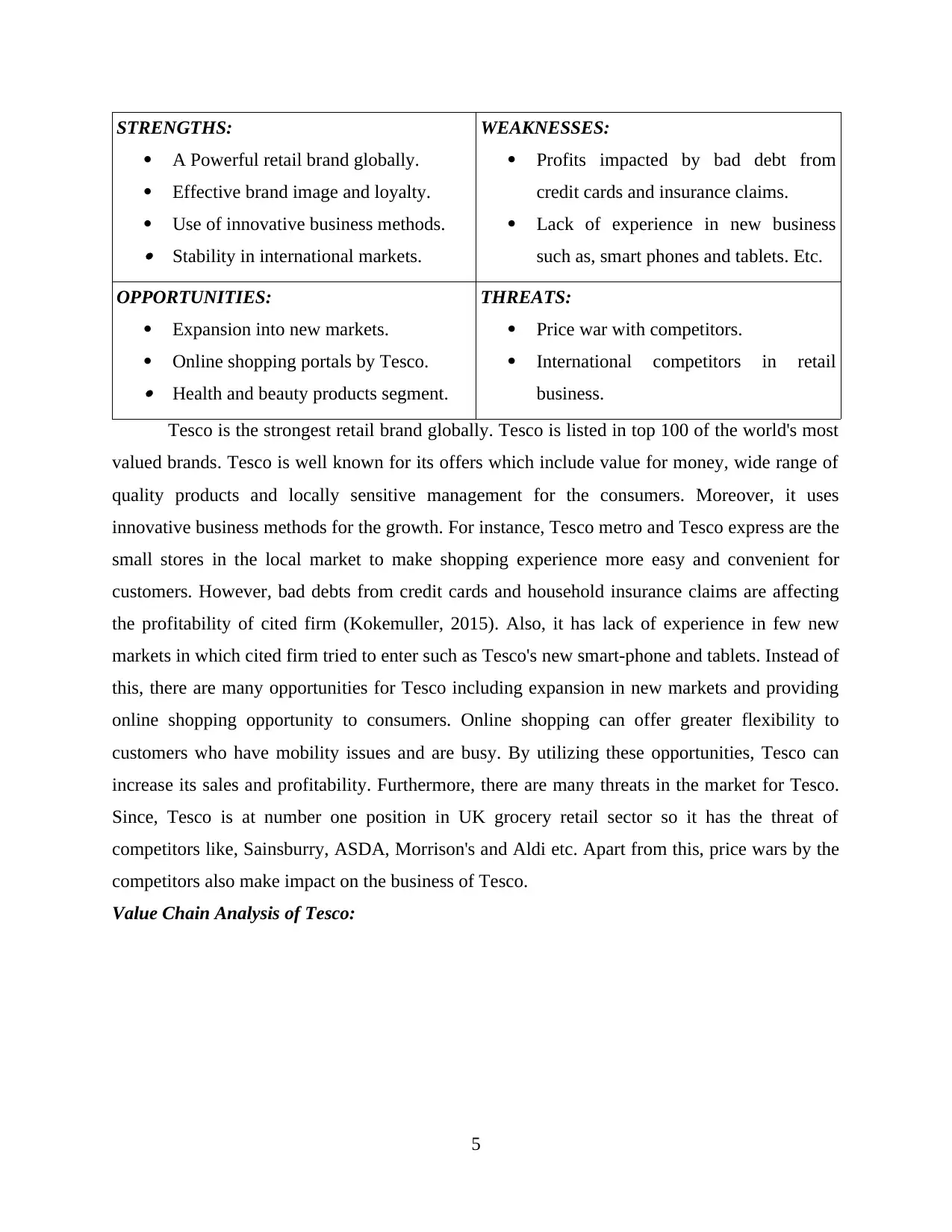
STRENGTHS:
A Powerful retail brand globally.
Effective brand image and loyalty.
Use of innovative business methods. Stability in international markets.
WEAKNESSES:
Profits impacted by bad debt from
credit cards and insurance claims.
Lack of experience in new business
such as, smart phones and tablets. Etc.
OPPORTUNITIES:
Expansion into new markets.
Online shopping portals by Tesco. Health and beauty products segment.
THREATS:
Price war with competitors.
International competitors in retail
business.
Tesco is the strongest retail brand globally. Tesco is listed in top 100 of the world's most
valued brands. Tesco is well known for its offers which include value for money, wide range of
quality products and locally sensitive management for the consumers. Moreover, it uses
innovative business methods for the growth. For instance, Tesco metro and Tesco express are the
small stores in the local market to make shopping experience more easy and convenient for
customers. However, bad debts from credit cards and household insurance claims are affecting
the profitability of cited firm (Kokemuller, 2015). Also, it has lack of experience in few new
markets in which cited firm tried to enter such as Tesco's new smart-phone and tablets. Instead of
this, there are many opportunities for Tesco including expansion in new markets and providing
online shopping opportunity to consumers. Online shopping can offer greater flexibility to
customers who have mobility issues and are busy. By utilizing these opportunities, Tesco can
increase its sales and profitability. Furthermore, there are many threats in the market for Tesco.
Since, Tesco is at number one position in UK grocery retail sector so it has the threat of
competitors like, Sainsburry, ASDA, Morrison's and Aldi etc. Apart from this, price wars by the
competitors also make impact on the business of Tesco.
Value Chain Analysis of Tesco:
5
A Powerful retail brand globally.
Effective brand image and loyalty.
Use of innovative business methods. Stability in international markets.
WEAKNESSES:
Profits impacted by bad debt from
credit cards and insurance claims.
Lack of experience in new business
such as, smart phones and tablets. Etc.
OPPORTUNITIES:
Expansion into new markets.
Online shopping portals by Tesco. Health and beauty products segment.
THREATS:
Price war with competitors.
International competitors in retail
business.
Tesco is the strongest retail brand globally. Tesco is listed in top 100 of the world's most
valued brands. Tesco is well known for its offers which include value for money, wide range of
quality products and locally sensitive management for the consumers. Moreover, it uses
innovative business methods for the growth. For instance, Tesco metro and Tesco express are the
small stores in the local market to make shopping experience more easy and convenient for
customers. However, bad debts from credit cards and household insurance claims are affecting
the profitability of cited firm (Kokemuller, 2015). Also, it has lack of experience in few new
markets in which cited firm tried to enter such as Tesco's new smart-phone and tablets. Instead of
this, there are many opportunities for Tesco including expansion in new markets and providing
online shopping opportunity to consumers. Online shopping can offer greater flexibility to
customers who have mobility issues and are busy. By utilizing these opportunities, Tesco can
increase its sales and profitability. Furthermore, there are many threats in the market for Tesco.
Since, Tesco is at number one position in UK grocery retail sector so it has the threat of
competitors like, Sainsburry, ASDA, Morrison's and Aldi etc. Apart from this, price wars by the
competitors also make impact on the business of Tesco.
Value Chain Analysis of Tesco:
5
Paraphrase This Document
Need a fresh take? Get an instant paraphrase of this document with our AI Paraphraser
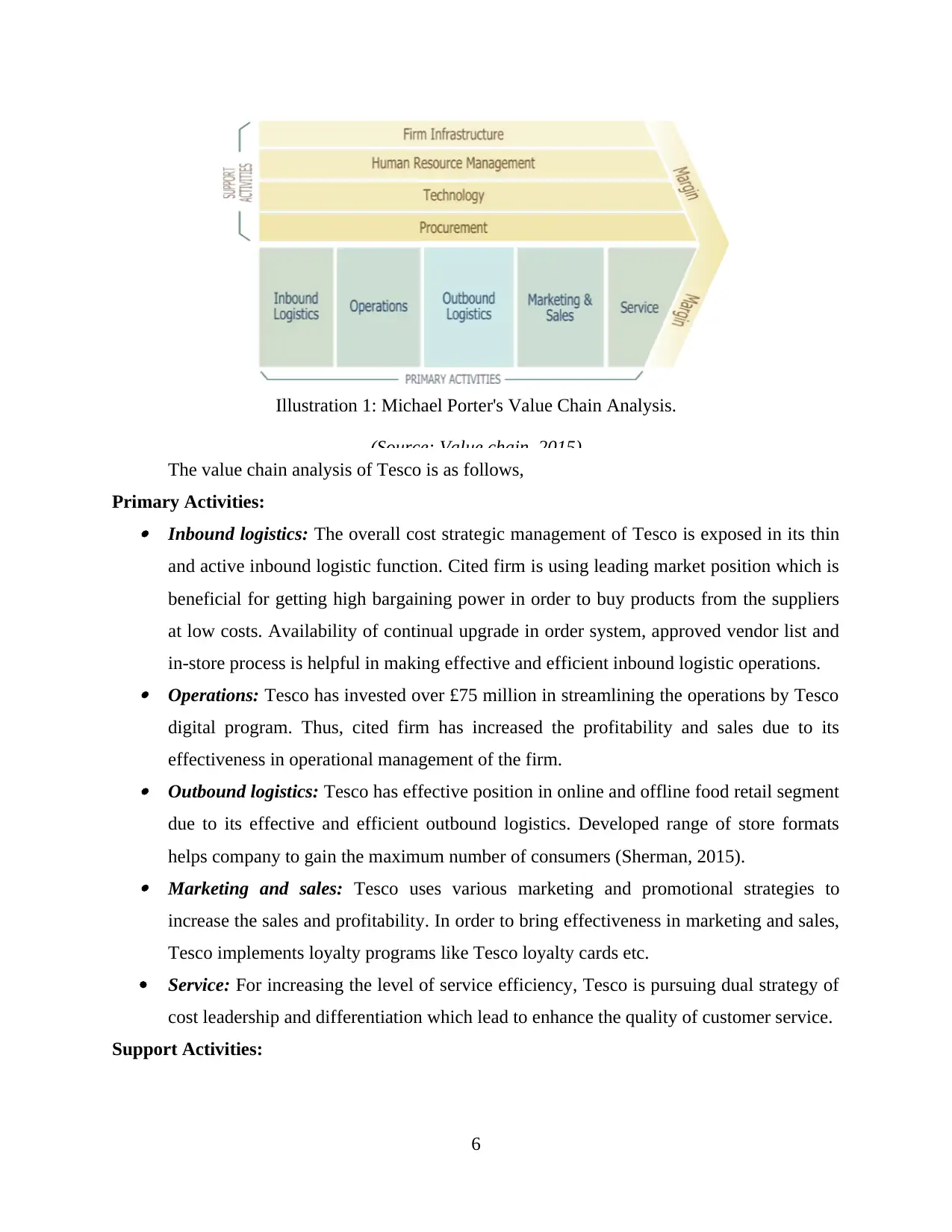
The value chain analysis of Tesco is as follows,
Primary Activities: Inbound logistics: The overall cost strategic management of Tesco is exposed in its thin
and active inbound logistic function. Cited firm is using leading market position which is
beneficial for getting high bargaining power in order to buy products from the suppliers
at low costs. Availability of continual upgrade in order system, approved vendor list and
in-store process is helpful in making effective and efficient inbound logistic operations. Operations: Tesco has invested over £75 million in streamlining the operations by Tesco
digital program. Thus, cited firm has increased the profitability and sales due to its
effectiveness in operational management of the firm. Outbound logistics: Tesco has effective position in online and offline food retail segment
due to its effective and efficient outbound logistics. Developed range of store formats
helps company to gain the maximum number of consumers (Sherman, 2015). Marketing and sales: Tesco uses various marketing and promotional strategies to
increase the sales and profitability. In order to bring effectiveness in marketing and sales,
Tesco implements loyalty programs like Tesco loyalty cards etc.
Service: For increasing the level of service efficiency, Tesco is pursuing dual strategy of
cost leadership and differentiation which lead to enhance the quality of customer service.
Support Activities:
6
Illustration 1: Michael Porter's Value Chain Analysis.
(Source: Value chain, 2015)
Primary Activities: Inbound logistics: The overall cost strategic management of Tesco is exposed in its thin
and active inbound logistic function. Cited firm is using leading market position which is
beneficial for getting high bargaining power in order to buy products from the suppliers
at low costs. Availability of continual upgrade in order system, approved vendor list and
in-store process is helpful in making effective and efficient inbound logistic operations. Operations: Tesco has invested over £75 million in streamlining the operations by Tesco
digital program. Thus, cited firm has increased the profitability and sales due to its
effectiveness in operational management of the firm. Outbound logistics: Tesco has effective position in online and offline food retail segment
due to its effective and efficient outbound logistics. Developed range of store formats
helps company to gain the maximum number of consumers (Sherman, 2015). Marketing and sales: Tesco uses various marketing and promotional strategies to
increase the sales and profitability. In order to bring effectiveness in marketing and sales,
Tesco implements loyalty programs like Tesco loyalty cards etc.
Service: For increasing the level of service efficiency, Tesco is pursuing dual strategy of
cost leadership and differentiation which lead to enhance the quality of customer service.
Support Activities:
6
Illustration 1: Michael Porter's Value Chain Analysis.
(Source: Value chain, 2015)
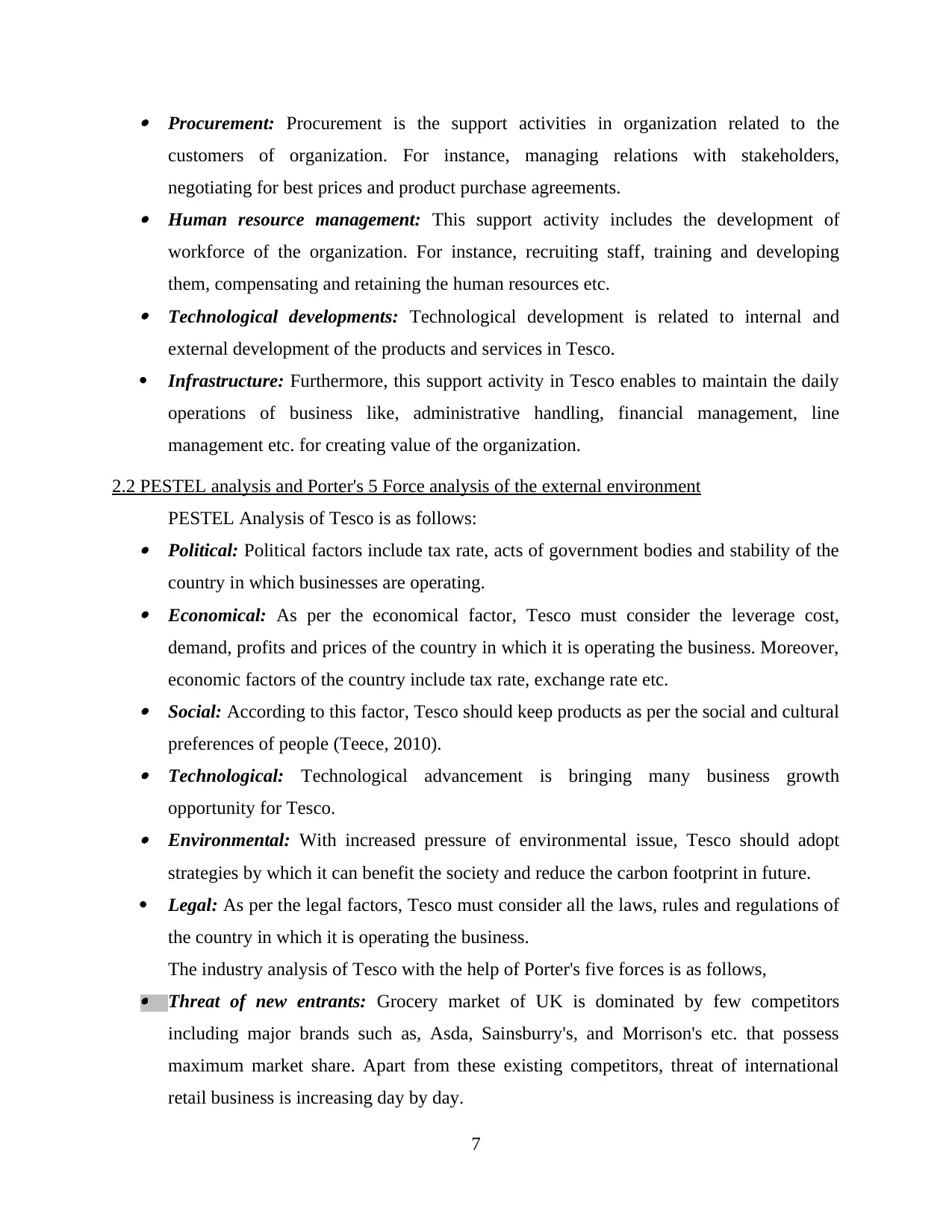
Procurement: Procurement is the support activities in organization related to the
customers of organization. For instance, managing relations with stakeholders,
negotiating for best prices and product purchase agreements. Human resource management: This support activity includes the development of
workforce of the organization. For instance, recruiting staff, training and developing
them, compensating and retaining the human resources etc. Technological developments: Technological development is related to internal and
external development of the products and services in Tesco.
Infrastructure: Furthermore, this support activity in Tesco enables to maintain the daily
operations of business like, administrative handling, financial management, line
management etc. for creating value of the organization.
2.2 PESTEL analysis and Porter's 5 Force analysis of the external environment
PESTEL Analysis of Tesco is as follows: Political: Political factors include tax rate, acts of government bodies and stability of the
country in which businesses are operating. Economical: As per the economical factor, Tesco must consider the leverage cost,
demand, profits and prices of the country in which it is operating the business. Moreover,
economic factors of the country include tax rate, exchange rate etc. Social: According to this factor, Tesco should keep products as per the social and cultural
preferences of people (Teece, 2010). Technological: Technological advancement is bringing many business growth
opportunity for Tesco. Environmental: With increased pressure of environmental issue, Tesco should adopt
strategies by which it can benefit the society and reduce the carbon footprint in future.
Legal: As per the legal factors, Tesco must consider all the laws, rules and regulations of
the country in which it is operating the business.
The industry analysis of Tesco with the help of Porter's five forces is as follows, Threat of new entrants: Grocery market of UK is dominated by few competitors
including major brands such as, Asda, Sainsburry's, and Morrison's etc. that possess
maximum market share. Apart from these existing competitors, threat of international
retail business is increasing day by day.
7
customers of organization. For instance, managing relations with stakeholders,
negotiating for best prices and product purchase agreements. Human resource management: This support activity includes the development of
workforce of the organization. For instance, recruiting staff, training and developing
them, compensating and retaining the human resources etc. Technological developments: Technological development is related to internal and
external development of the products and services in Tesco.
Infrastructure: Furthermore, this support activity in Tesco enables to maintain the daily
operations of business like, administrative handling, financial management, line
management etc. for creating value of the organization.
2.2 PESTEL analysis and Porter's 5 Force analysis of the external environment
PESTEL Analysis of Tesco is as follows: Political: Political factors include tax rate, acts of government bodies and stability of the
country in which businesses are operating. Economical: As per the economical factor, Tesco must consider the leverage cost,
demand, profits and prices of the country in which it is operating the business. Moreover,
economic factors of the country include tax rate, exchange rate etc. Social: According to this factor, Tesco should keep products as per the social and cultural
preferences of people (Teece, 2010). Technological: Technological advancement is bringing many business growth
opportunity for Tesco. Environmental: With increased pressure of environmental issue, Tesco should adopt
strategies by which it can benefit the society and reduce the carbon footprint in future.
Legal: As per the legal factors, Tesco must consider all the laws, rules and regulations of
the country in which it is operating the business.
The industry analysis of Tesco with the help of Porter's five forces is as follows, Threat of new entrants: Grocery market of UK is dominated by few competitors
including major brands such as, Asda, Sainsburry's, and Morrison's etc. that possess
maximum market share. Apart from these existing competitors, threat of international
retail business is increasing day by day.
7
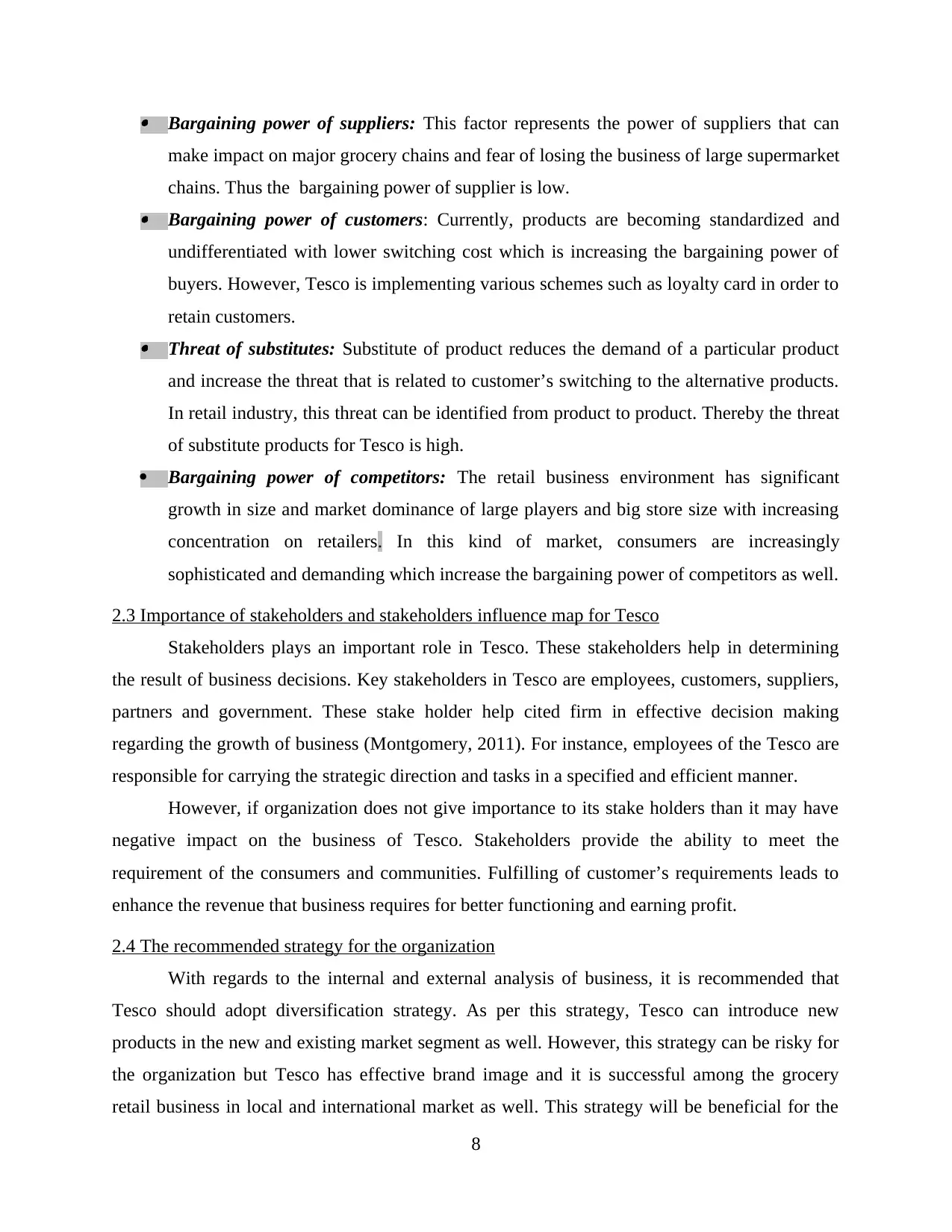
Bargaining power of suppliers: This factor represents the power of suppliers that can
make impact on major grocery chains and fear of losing the business of large supermarket
chains. Thus the bargaining power of supplier is low. Bargaining power of customers: Currently, products are becoming standardized and
undifferentiated with lower switching cost which is increasing the bargaining power of
buyers. However, Tesco is implementing various schemes such as loyalty card in order to
retain customers. Threat of substitutes: Substitute of product reduces the demand of a particular product
and increase the threat that is related to customer’s switching to the alternative products.
In retail industry, this threat can be identified from product to product. Thereby the threat
of substitute products for Tesco is high.
Bargaining power of competitors: The retail business environment has significant
growth in size and market dominance of large players and big store size with increasing
concentration on retailers. In this kind of market, consumers are increasingly
sophisticated and demanding which increase the bargaining power of competitors as well.
2.3 Importance of stakeholders and stakeholders influence map for Tesco
Stakeholders plays an important role in Tesco. These stakeholders help in determining
the result of business decisions. Key stakeholders in Tesco are employees, customers, suppliers,
partners and government. These stake holder help cited firm in effective decision making
regarding the growth of business (Montgomery, 2011). For instance, employees of the Tesco are
responsible for carrying the strategic direction and tasks in a specified and efficient manner.
However, if organization does not give importance to its stake holders than it may have
negative impact on the business of Tesco. Stakeholders provide the ability to meet the
requirement of the consumers and communities. Fulfilling of customer’s requirements leads to
enhance the revenue that business requires for better functioning and earning profit.
2.4 The recommended strategy for the organization
With regards to the internal and external analysis of business, it is recommended that
Tesco should adopt diversification strategy. As per this strategy, Tesco can introduce new
products in the new and existing market segment as well. However, this strategy can be risky for
the organization but Tesco has effective brand image and it is successful among the grocery
retail business in local and international market as well. This strategy will be beneficial for the
8
make impact on major grocery chains and fear of losing the business of large supermarket
chains. Thus the bargaining power of supplier is low. Bargaining power of customers: Currently, products are becoming standardized and
undifferentiated with lower switching cost which is increasing the bargaining power of
buyers. However, Tesco is implementing various schemes such as loyalty card in order to
retain customers. Threat of substitutes: Substitute of product reduces the demand of a particular product
and increase the threat that is related to customer’s switching to the alternative products.
In retail industry, this threat can be identified from product to product. Thereby the threat
of substitute products for Tesco is high.
Bargaining power of competitors: The retail business environment has significant
growth in size and market dominance of large players and big store size with increasing
concentration on retailers. In this kind of market, consumers are increasingly
sophisticated and demanding which increase the bargaining power of competitors as well.
2.3 Importance of stakeholders and stakeholders influence map for Tesco
Stakeholders plays an important role in Tesco. These stakeholders help in determining
the result of business decisions. Key stakeholders in Tesco are employees, customers, suppliers,
partners and government. These stake holder help cited firm in effective decision making
regarding the growth of business (Montgomery, 2011). For instance, employees of the Tesco are
responsible for carrying the strategic direction and tasks in a specified and efficient manner.
However, if organization does not give importance to its stake holders than it may have
negative impact on the business of Tesco. Stakeholders provide the ability to meet the
requirement of the consumers and communities. Fulfilling of customer’s requirements leads to
enhance the revenue that business requires for better functioning and earning profit.
2.4 The recommended strategy for the organization
With regards to the internal and external analysis of business, it is recommended that
Tesco should adopt diversification strategy. As per this strategy, Tesco can introduce new
products in the new and existing market segment as well. However, this strategy can be risky for
the organization but Tesco has effective brand image and it is successful among the grocery
retail business in local and international market as well. This strategy will be beneficial for the
8
Secure Best Marks with AI Grader
Need help grading? Try our AI Grader for instant feedback on your assignments.
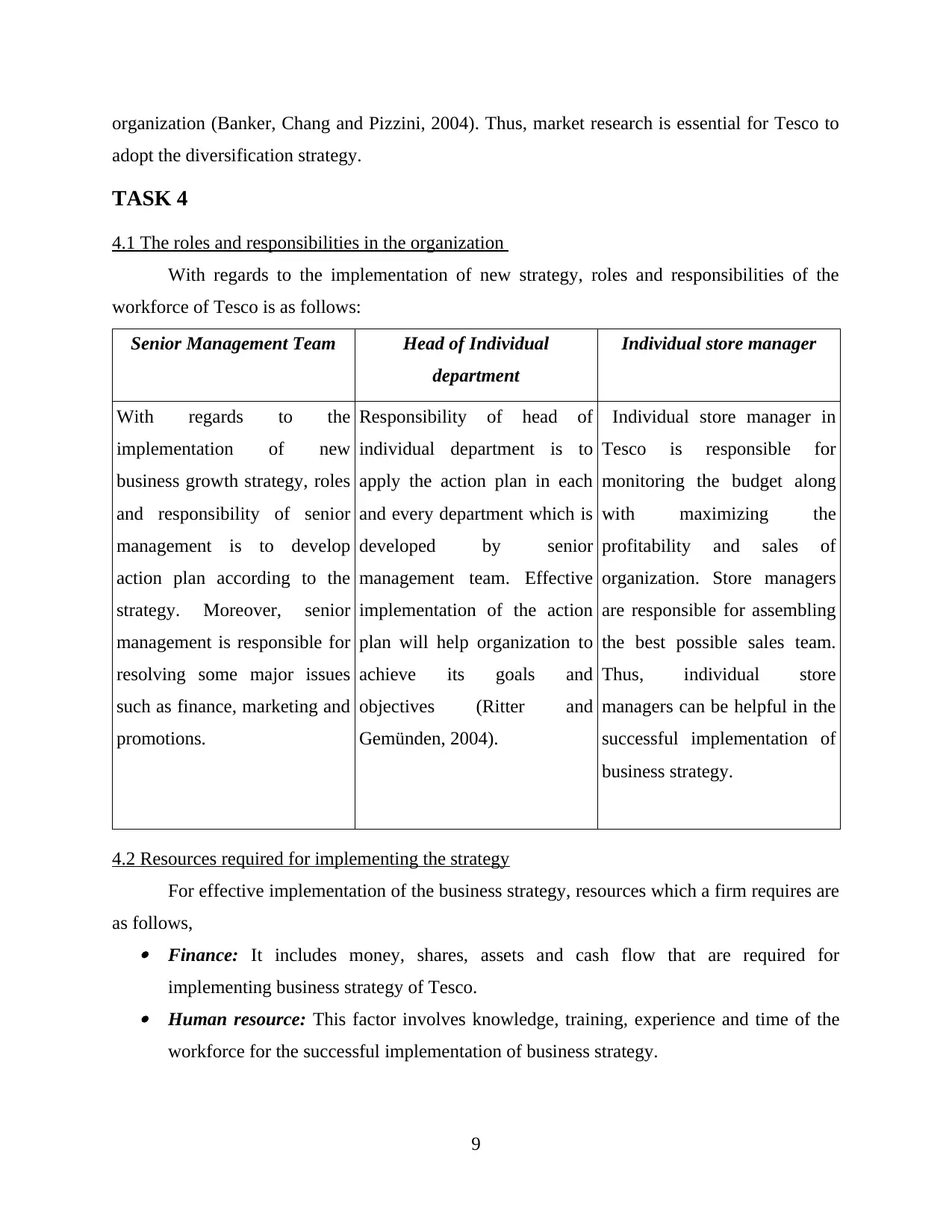
organization (Banker, Chang and Pizzini, 2004). Thus, market research is essential for Tesco to
adopt the diversification strategy.
TASK 4
4.1 The roles and responsibilities in the organization
With regards to the implementation of new strategy, roles and responsibilities of the
workforce of Tesco is as follows:
Senior Management Team Head of Individual
department
Individual store manager
With regards to the
implementation of new
business growth strategy, roles
and responsibility of senior
management is to develop
action plan according to the
strategy. Moreover, senior
management is responsible for
resolving some major issues
such as finance, marketing and
promotions.
Responsibility of head of
individual department is to
apply the action plan in each
and every department which is
developed by senior
management team. Effective
implementation of the action
plan will help organization to
achieve its goals and
objectives (Ritter and
Gemünden, 2004).
Individual store manager in
Tesco is responsible for
monitoring the budget along
with maximizing the
profitability and sales of
organization. Store managers
are responsible for assembling
the best possible sales team.
Thus, individual store
managers can be helpful in the
successful implementation of
business strategy.
4.2 Resources required for implementing the strategy
For effective implementation of the business strategy, resources which a firm requires are
as follows, Finance: It includes money, shares, assets and cash flow that are required for
implementing business strategy of Tesco. Human resource: This factor involves knowledge, training, experience and time of the
workforce for the successful implementation of business strategy.
9
adopt the diversification strategy.
TASK 4
4.1 The roles and responsibilities in the organization
With regards to the implementation of new strategy, roles and responsibilities of the
workforce of Tesco is as follows:
Senior Management Team Head of Individual
department
Individual store manager
With regards to the
implementation of new
business growth strategy, roles
and responsibility of senior
management is to develop
action plan according to the
strategy. Moreover, senior
management is responsible for
resolving some major issues
such as finance, marketing and
promotions.
Responsibility of head of
individual department is to
apply the action plan in each
and every department which is
developed by senior
management team. Effective
implementation of the action
plan will help organization to
achieve its goals and
objectives (Ritter and
Gemünden, 2004).
Individual store manager in
Tesco is responsible for
monitoring the budget along
with maximizing the
profitability and sales of
organization. Store managers
are responsible for assembling
the best possible sales team.
Thus, individual store
managers can be helpful in the
successful implementation of
business strategy.
4.2 Resources required for implementing the strategy
For effective implementation of the business strategy, resources which a firm requires are
as follows, Finance: It includes money, shares, assets and cash flow that are required for
implementing business strategy of Tesco. Human resource: This factor involves knowledge, training, experience and time of the
workforce for the successful implementation of business strategy.
9
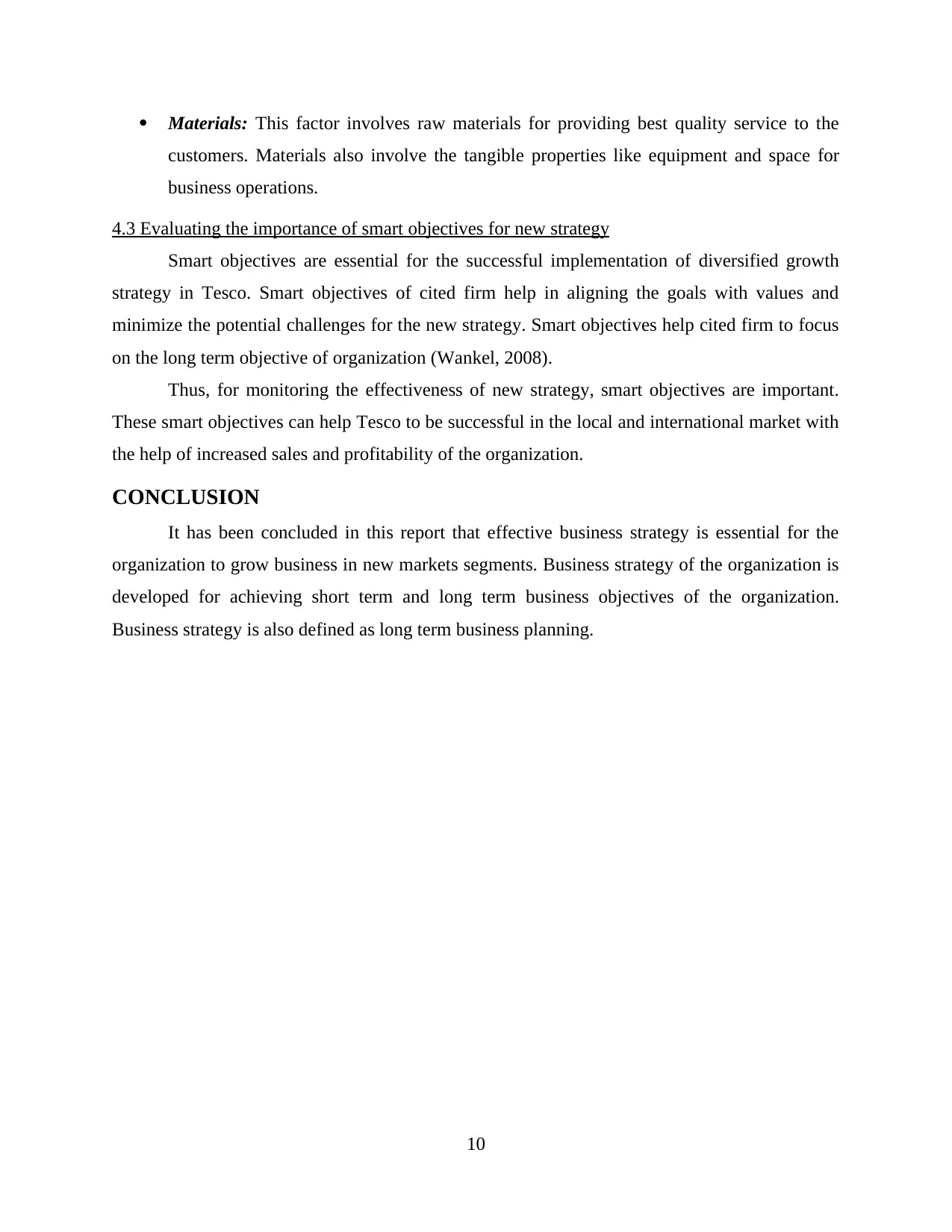
Materials: This factor involves raw materials for providing best quality service to the
customers. Materials also involve the tangible properties like equipment and space for
business operations.
4.3 Evaluating the importance of smart objectives for new strategy
Smart objectives are essential for the successful implementation of diversified growth
strategy in Tesco. Smart objectives of cited firm help in aligning the goals with values and
minimize the potential challenges for the new strategy. Smart objectives help cited firm to focus
on the long term objective of organization (Wankel, 2008).
Thus, for monitoring the effectiveness of new strategy, smart objectives are important.
These smart objectives can help Tesco to be successful in the local and international market with
the help of increased sales and profitability of the organization.
CONCLUSION
It has been concluded in this report that effective business strategy is essential for the
organization to grow business in new markets segments. Business strategy of the organization is
developed for achieving short term and long term business objectives of the organization.
Business strategy is also defined as long term business planning.
10
customers. Materials also involve the tangible properties like equipment and space for
business operations.
4.3 Evaluating the importance of smart objectives for new strategy
Smart objectives are essential for the successful implementation of diversified growth
strategy in Tesco. Smart objectives of cited firm help in aligning the goals with values and
minimize the potential challenges for the new strategy. Smart objectives help cited firm to focus
on the long term objective of organization (Wankel, 2008).
Thus, for monitoring the effectiveness of new strategy, smart objectives are important.
These smart objectives can help Tesco to be successful in the local and international market with
the help of increased sales and profitability of the organization.
CONCLUSION
It has been concluded in this report that effective business strategy is essential for the
organization to grow business in new markets segments. Business strategy of the organization is
developed for achieving short term and long term business objectives of the organization.
Business strategy is also defined as long term business planning.
10
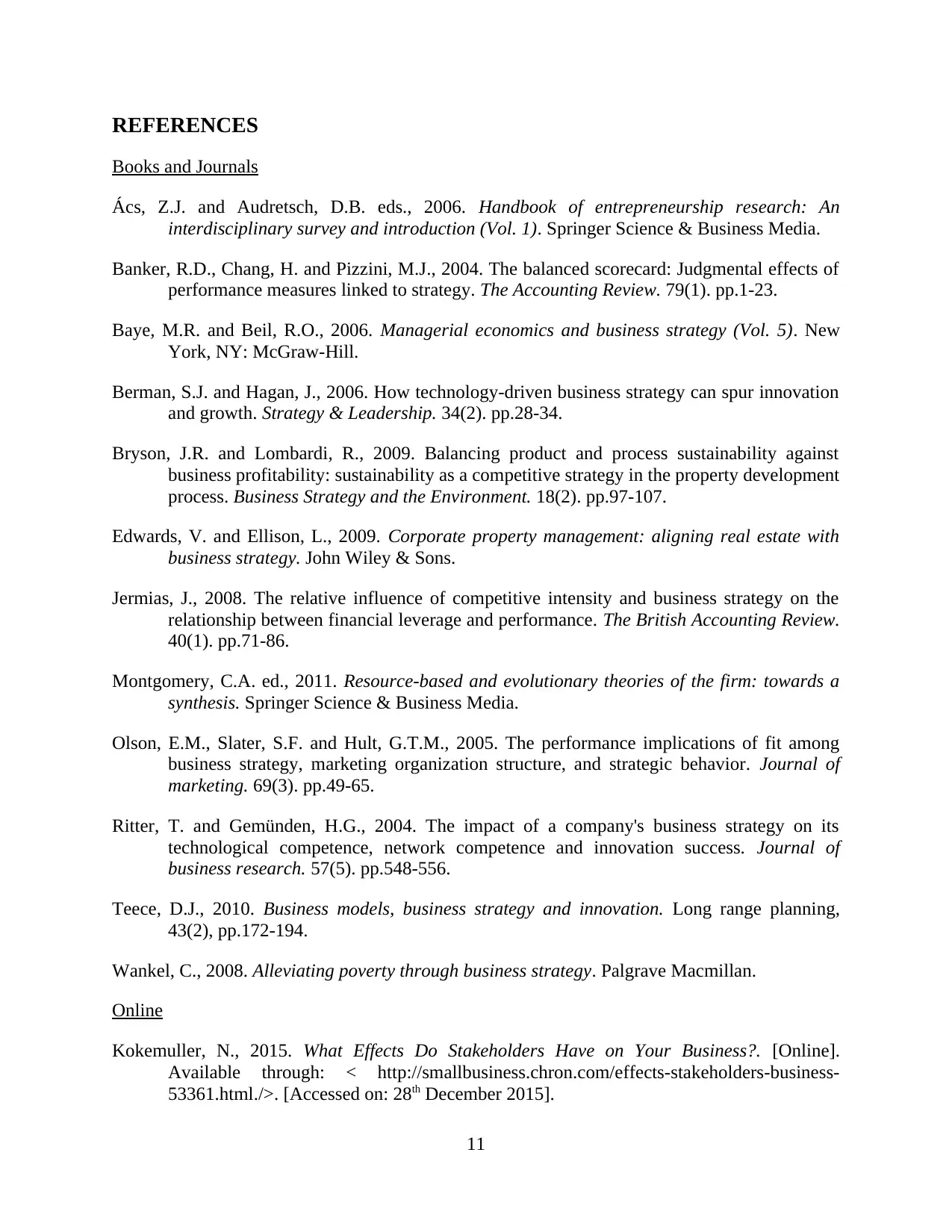
REFERENCES
Books and Journals
Ács, Z.J. and Audretsch, D.B. eds., 2006. Handbook of entrepreneurship research: An
interdisciplinary survey and introduction (Vol. 1). Springer Science & Business Media.
Banker, R.D., Chang, H. and Pizzini, M.J., 2004. The balanced scorecard: Judgmental effects of
performance measures linked to strategy. The Accounting Review. 79(1). pp.1-23.
Baye, M.R. and Beil, R.O., 2006. Managerial economics and business strategy (Vol. 5). New
York, NY: McGraw-Hill.
Berman, S.J. and Hagan, J., 2006. How technology-driven business strategy can spur innovation
and growth. Strategy & Leadership. 34(2). pp.28-34.
Bryson, J.R. and Lombardi, R., 2009. Balancing product and process sustainability against
business profitability: sustainability as a competitive strategy in the property development
process. Business Strategy and the Environment. 18(2). pp.97-107.
Edwards, V. and Ellison, L., 2009. Corporate property management: aligning real estate with
business strategy. John Wiley & Sons.
Jermias, J., 2008. The relative influence of competitive intensity and business strategy on the
relationship between financial leverage and performance. The British Accounting Review.
40(1). pp.71-86.
Montgomery, C.A. ed., 2011. Resource-based and evolutionary theories of the firm: towards a
synthesis. Springer Science & Business Media.
Olson, E.M., Slater, S.F. and Hult, G.T.M., 2005. The performance implications of fit among
business strategy, marketing organization structure, and strategic behavior. Journal of
marketing. 69(3). pp.49-65.
Ritter, T. and Gemünden, H.G., 2004. The impact of a company's business strategy on its
technological competence, network competence and innovation success. Journal of
business research. 57(5). pp.548-556.
Teece, D.J., 2010. Business models, business strategy and innovation. Long range planning,
43(2), pp.172-194.
Wankel, C., 2008. Alleviating poverty through business strategy. Palgrave Macmillan.
Online
Kokemuller, N., 2015. What Effects Do Stakeholders Have on Your Business?. [Online].
Available through: < http://smallbusiness.chron.com/effects-stakeholders-business-
53361.html./>. [Accessed on: 28th December 2015].
11
Books and Journals
Ács, Z.J. and Audretsch, D.B. eds., 2006. Handbook of entrepreneurship research: An
interdisciplinary survey and introduction (Vol. 1). Springer Science & Business Media.
Banker, R.D., Chang, H. and Pizzini, M.J., 2004. The balanced scorecard: Judgmental effects of
performance measures linked to strategy. The Accounting Review. 79(1). pp.1-23.
Baye, M.R. and Beil, R.O., 2006. Managerial economics and business strategy (Vol. 5). New
York, NY: McGraw-Hill.
Berman, S.J. and Hagan, J., 2006. How technology-driven business strategy can spur innovation
and growth. Strategy & Leadership. 34(2). pp.28-34.
Bryson, J.R. and Lombardi, R., 2009. Balancing product and process sustainability against
business profitability: sustainability as a competitive strategy in the property development
process. Business Strategy and the Environment. 18(2). pp.97-107.
Edwards, V. and Ellison, L., 2009. Corporate property management: aligning real estate with
business strategy. John Wiley & Sons.
Jermias, J., 2008. The relative influence of competitive intensity and business strategy on the
relationship between financial leverage and performance. The British Accounting Review.
40(1). pp.71-86.
Montgomery, C.A. ed., 2011. Resource-based and evolutionary theories of the firm: towards a
synthesis. Springer Science & Business Media.
Olson, E.M., Slater, S.F. and Hult, G.T.M., 2005. The performance implications of fit among
business strategy, marketing organization structure, and strategic behavior. Journal of
marketing. 69(3). pp.49-65.
Ritter, T. and Gemünden, H.G., 2004. The impact of a company's business strategy on its
technological competence, network competence and innovation success. Journal of
business research. 57(5). pp.548-556.
Teece, D.J., 2010. Business models, business strategy and innovation. Long range planning,
43(2), pp.172-194.
Wankel, C., 2008. Alleviating poverty through business strategy. Palgrave Macmillan.
Online
Kokemuller, N., 2015. What Effects Do Stakeholders Have on Your Business?. [Online].
Available through: < http://smallbusiness.chron.com/effects-stakeholders-business-
53361.html./>. [Accessed on: 28th December 2015].
11
Paraphrase This Document
Need a fresh take? Get an instant paraphrase of this document with our AI Paraphraser
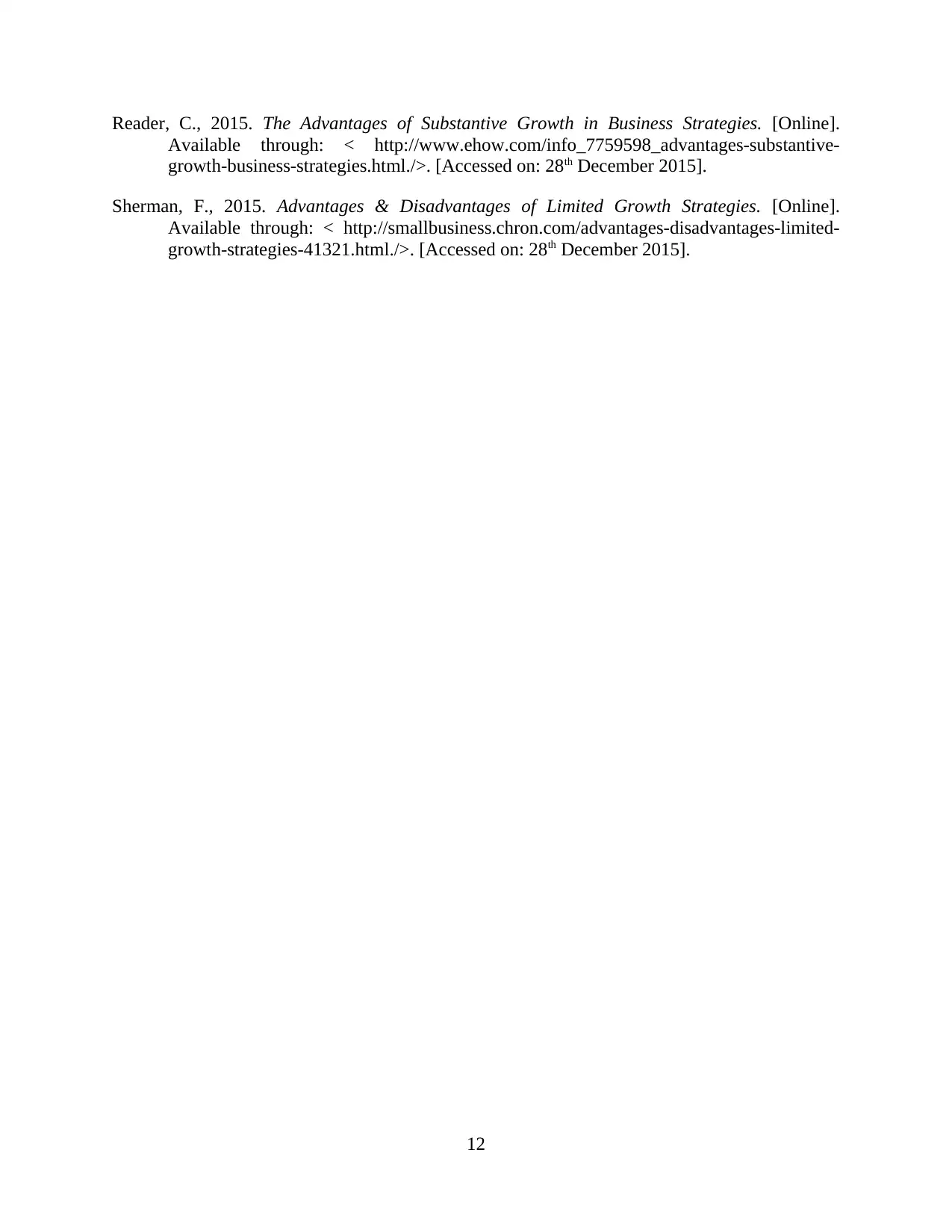
Reader, C., 2015. The Advantages of Substantive Growth in Business Strategies. [Online].
Available through: < http://www.ehow.com/info_7759598_advantages-substantive-
growth-business-strategies.html./>. [Accessed on: 28th December 2015].
Sherman, F., 2015. Advantages & Disadvantages of Limited Growth Strategies. [Online].
Available through: < http://smallbusiness.chron.com/advantages-disadvantages-limited-
growth-strategies-41321.html./>. [Accessed on: 28th December 2015].
12
Available through: < http://www.ehow.com/info_7759598_advantages-substantive-
growth-business-strategies.html./>. [Accessed on: 28th December 2015].
Sherman, F., 2015. Advantages & Disadvantages of Limited Growth Strategies. [Online].
Available through: < http://smallbusiness.chron.com/advantages-disadvantages-limited-
growth-strategies-41321.html./>. [Accessed on: 28th December 2015].
12
1 out of 14
Related Documents
Your All-in-One AI-Powered Toolkit for Academic Success.
+13062052269
info@desklib.com
Available 24*7 on WhatsApp / Email
![[object Object]](/_next/static/media/star-bottom.7253800d.svg)
Unlock your academic potential
© 2024 | Zucol Services PVT LTD | All rights reserved.





![[FULL ACCESS] Strategic Management and Marketing Analysis of Tesco Supermarket](/_next/image/?url=https%3A%2F%2Fdesklib.com%2Fmedia%2Fimages%2Fhg%2Fb849fd3ee8b6419b8351aeff27b7fa6f.jpg&w=256&q=75)